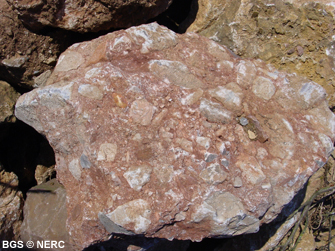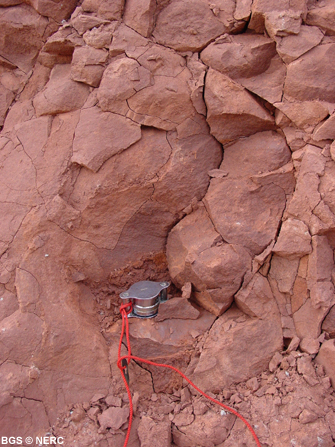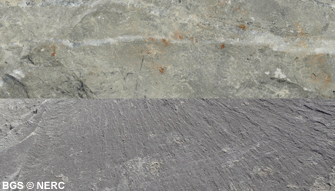
The rocks of Mendip
Silurian | Devonian | Lower Carboniferous | Upper Carboniferous | Triassic | Lower to Middle Jurassic
Triassic rocks (251 to 200 million years ago)
In the Triassic, Britain was part of the vast supercontinent of Pangaea, into which many of the world's landmasses were grouped. Mountains, including the Mendips, created by uplift at the end of the Carboniferous were rapidly being eroded. The coarse-grained products of this erosion are represented by the Dolomitic Conglomerate, and the finer-grained material forms the Mercia Mudstone Group. In the Late Triassic, the sea began to invade the Mendip area as well as other parts of the UK, producing the greenish-grey rocks of the Blue Anchor Formation at the top of the Mercia Mudstone Group and the fossiliferous mudstones and limestones of the Penarth Group.
Dolomitic Conglomerate

This coarse-grained rock consists of boulders and smaller fragments of Carboniferous Limestone, and less commonly Portishead Formation sandstone, bound together with finer-grained sediment. The rock was deposited in steep-sided desert canyons, called wadis, and on steep mountain slopes. It represents the material eroded from the Mendips not long after they were formed by a mountain-building phase in the Late Carboniferous and Permian. Some parts of the Dolomitic Conglomerate represent fossil scree deposits, which are characterised by a jumble of large, angular blocks with relatively little fine sediment between them. These deposits formed close to the eroding mountain slopes. In contrast, units containing a mixture of more rounded blocks with fine sediment infilling gaps between them, have experienced a greater degree of transport away from their source area, probably by periodic flash floods.
Mercia Mudstone Group

These rocks are red mudstones, siltstones and sandstones, and represent the finer-grained products formed by the erosion of the Mendips during the Triassic. The mudstones were mostly deposited from temporary lakes formed in part by flash floods or seasonal rains emptying out from confined upland regions. Consequently, these sediments are thin or absent over the Mendip plateau, and either interfinger with the Dolomitic Conglomerate, or overlie it. The rocks forming the youngest part of the Mercia Mudstone, named the Blue Anchor Formation, are greenish-grey rocks rather than red, and contain marine microfossils, showing that the sea had started to advance across the Mendip region.
Penarth Group

The Penarth Group is a thin succession of dark, organic-rich mudstones (Westbury Formation), fine-grained limestones (Langport Member) and conglomerates. At the base of these rocks, a bone bed is sometimes developed (known as the Rhaetic Bone Bed), containing the bones and teeth of marine and freshwater fish and reptiles (including Ichthyosaurus and Plesiosaurus). The sediments represent a variety of shallow marine, lagoonal and near-shore environments, reflecting the early stages of submergence of the land surface that heralded the shallow seas of the Lower Jurassic.
- Home
- Overview maps
- Locality
areas
- Cheddar Gorge
- Charterhouse
- Blackdown
- Burrington Combe
- Shipham & Rowberrow
- Crook Peak & Axbridge
- Banwell to Churchill
- Priddy
- Harptree & Smitham Hill
- Draycott & Westbury-sub-Mendip
- Wookey Hole & Ebbor Gorge
- Wells
- Great Elm & Vallis Vale
- Mells & the Wadbury Valley
- The Vobster area
- The Whatley area
- Torr Works & Asham Wood
- Beacon Hill
- Stoke St Michael & Oakhill
- Holwell & Nunney
- Shepton Mallet & Maesbury
- Gurney Slade & Emborough
- The Nettlebridge valley
- Geology
- Minerals and mines
- Quarrying
- Caves and karst
- Biodiversity
- Detailed site information
- Acknowledgements
- External links
- Search
- Site map